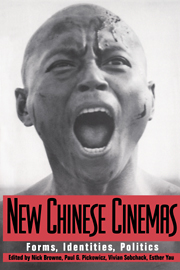Introduction
Published online by Cambridge University Press: 05 June 2012
Summary
For a Western audience, the presentation of essays on Chinese cinema of the 1980s implies a distance of both culture and interpretation. This distance for film scholars may have a paradoxical aspect – disclosing a fascinating spectacle of another world under a familiar form of analysis. For scholars of Chinese history and literature, a book that takes Chinese film as a central instance of popular culture – one, moreover, that approaches its object through the languages of Western critical theory – may seem novel and strange. Nonetheless, the critical space created by this necessary crossing of perspectives provides a way to come to terms with the forms and meanings of Chinese filmmaking of the 1980s and to examine the way film occupies, within the sphere of Chinese popular culture, the contested space between art, entertainment, and national politics.
The presumption that Chinese cinema is the monolithic cultural expression of a Chinese nation has been dramatically undercut by history. “China” appears today largely as the consequence of the 1949 Communist revolution, forming an interregional social and economic network defined and sustained by politics. The People's Republic, Taiwan, and Hong Kong and their cinemas are marked as socialist, capitalist, and colonialist, respectively. Yet to exaggerate these differences would be to overlook a common cultural tradition of social, ideological, and aesthetic forms that stands behind and informs Chinese cinema as a whole.
- Type
- Chapter
- Information
- New Chinese CinemasForms, Identities, Politics, pp. 1 - 12Publisher: Cambridge University PressPrint publication year: 1994



